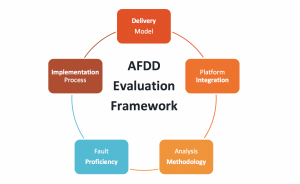Our previous blog in this series ended with the question, “why implement fault detection and diagnostics in buildings?” Whether you are already convinced that your organization needs to jump on the Automated Fault Detection and Diagnostics (AFDD) bandwagon, or you are still wondering if such a solution would really make a difference in your complex world of facility management, this article should offer additional insights and practical advice to both ends of the spectrum.
Before diving into the AFDD tools available today, we should point out that choosing the right technology is not the only ingredient necessary for success. An earlier blog on “What does it take to become analytic-driven?” reveals other considerations forward-thinking organizations must keep in mind.
While this blog doesn’t focus on specific products in the market today, it establishes a framework to help evaluate them and, ultimately, guide the decision-making process. This framework will cover five major areas, delivery model, platform integration, analysis methodology, fault proficiency, and implementation process. It should be acknowledged that the following resource has provided valuable content to this blog: Lawrence Berkeley National Laboratory’s Characterization and Survey of Automated Fault Detection and Diagnostic Tools, November 2017 report.
We will discuss Delivery Model and Platform Integration in this blog, with an upcoming blog considering the remaining three areas. 
“Where is the AFDD tool’s software going to reside?”
Cloud computing continues to experience incredible growth around us, with a multitude of applications and services offered from remote servers via the world wide web, including the delivery of energy management solutions such as AFDD tools. With continual advancements in scalability, speed and security, Software-as-a-Service (SaaS) has become the model of choice over on-premise deployments. Managed by the service provider, users would benefit from software improvements with regular updates and feature releases without the need to run software patches or install new code.
In rare instances where institutional or corporate policies would only favor on-premise solutions, such offerings are still available. However, make sure the differences and possible limitations are clearly understood before deciding to move forward with this model.
“How will the AFDD tool integrate with the existing building management system?”
Data access is a critical piece when planning the deployment of an AFDD solution. Having a robust Building Automation System (BAS) is a great start as service providers use special devices to connect and retrieve building data on a variety of open and proprietary protocols, including ASHRAE’s BACnet™ as well as vendor-specific protocols. Once these data collectors are integrated with the BAS network, they would either fetch existing historical data in the form of trend logs or capture real-time values from sensors and control devices, taking samples at regular intervals.
Whenever BAS networks aren’t accessible to data collectors, service providers use software connectors to interface directly with third-party databases and end devices, typically through an Application Programming Interface (API) or other integration mechanisms.
Having valid and reliable building data is the key to successful AFDD implementation. Data collection versatility is a must-have requirement from your service provider, especially when disparate systems and vendors is the norm in your facility.
Up next
In our next blog, we wrap up our discussion on evaluating AFDD technologies. In the meantime, give CopperTree Analytics a call should you find yourself reviewing energy analytics solutions and would like to learn more about this rapidly evolving field.



